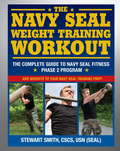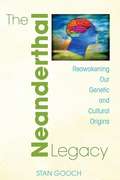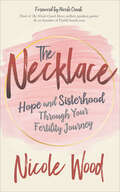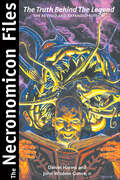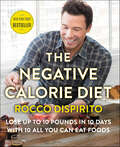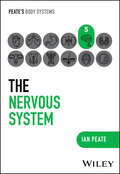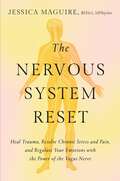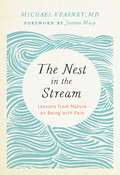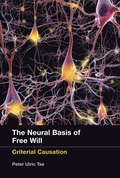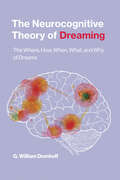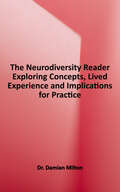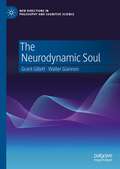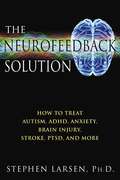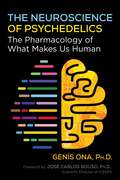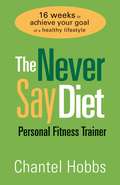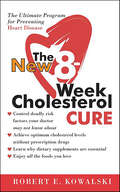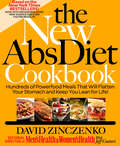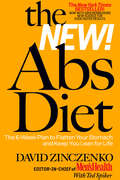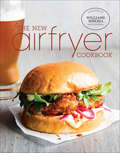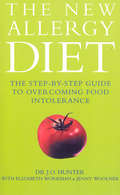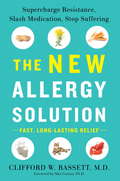- Table View
- List View
The Navy SEAL Weight Training Workout
by Stewart Smith Peter Field PeckAdd weights to your NAVY SEAL Training prep!The Navy SEAL Weight Training Workout is an effective weight lifting program designed to maintain muscle growth and avoid over-training in high-repetition and high-mileage running and fitness routines like those used by Navy SEALs.Pushing your fitness to the extremes is a necessary part of a rigorous regimen like Navy SEAL training. But for maximum results, it's crucial to incorporate a periodization program that creates a break from all the elements of your regular routine. Fitness is a journey, not a destination, and Navy SEAL Weight Training is the perfect guide to keeping you on the road to becoming fit and strong, Navy SEAL-style!The Navy SEAL Weight Training Workout has been specially designed for those who have a solid foundation of training under their belts and are looking for new ideas to add or replace their existing routines. The workouts incorporate weight training exercises, along with running, biking, or swimming and moderate repetitions of calisthenics for the ultimate recovery program built for boosting results.Based on actual Navy SEAL training routines, Special Ops Team Coach Stew Smith has developed The Navy SEAL Weight Training Workout to help keep you going strong, just like the Navy SEALs.
The Neanderthal Legacy: Reawakening Our Genetic and Cultural Origins
by Stan GoochA direct appeal for a revolution in our educational system to restore the connection with our Neanderthal heritage • Examines the genetic evidence for Neanderthal/Cro-Magnon crossbreeding and the dual-nature effects this hybrid cross produced • Explains the influence of the Neanderthal’s enlarged cerebellum on our modern brain function and psychic and paranormal abilities In The Neanderthal Legacy, eminent psychologist and paranormal researcher Stan Gooch brings together the wide-ranging investigative strands of his lifetime of study of the human brain. One of the world’s leading experts on the influence of Neanderthal Man on the cultural and biological development of humanity, Gooch contends that the Neanderthals’ enlarged cerebellum was a source of deep connection with the psychic and dream worlds, which remains extant in modern man in paranormal phenomena that conventional science cannot explain.Gooch offers new scientific evidence of the crossbreeding between Neanderthals and Cro-Magnons that is responsible for the dichotomous nature of our feelings, thoughts, impressions, beliefs, and even our cultural mores and politics. The “hybrid vigor” produced by this mating has gifted modern man with abilities and sensibilities that the scientific establishment and conventional educational system entirely ignore. The author explores the legacy of our Neanderthal ancestors in an effort to awaken their virtues and qualities, which are so needed in our modern world.
The Neck Pain Handbook
by M.D. Grant Cooper M.D. Alex ViscoThe Neck Pain Handbook discusses everything you need to know about neck pain, including its causes, how to treat it yourself, when it's time to see a doctor, and what your doctor can do to help. Most importantly, it discusses how you can prevent neck pain, so that once your pain is gone, it stays gone.Neck pain is increasingly common as more of us work in offices that make it unnecessary to move from our computers and desks. Major topics discussed include a discussion of why the neck is one of the most common areas to develop pain as the result of our increasingly immobile lifestyle, and how pain is rooted in the neck's complex anatomy and function. With this information, it becomes clear why the strategies for dealing with it are recommended. These include: the importance of good posture while sitting, standing, walking, and sleeping; setting up your workplace for optimal comfort and support, to prevent injury; a simple and effective 10-minute exercise program for your neck, including stretches and strength training, that will help to take away the pain and keep it from coming back; medical options when improving posture and simple exercises don't help; a discussion of the symptoms that mean a physician should be consulted; and the approaches that will be used if medical intervention is needed.In addition, for the 10-20% of people with neck pain that does not respond to conservative therapy, the authors discuss in detail options such as medications, injections, and-rarely needed-surgery
The Necklace: Hope and Sisterhood Through Your Fertility Journey
by Nicole WoodA powerful true story that follows the miraculous events of a tiny mustard seed necklace on several women’s emotional infertility journeys.
The Necronomicon Files: The Truth Behind The Legend
by Daniel Harms John Wisdom Gonce IIIOccult scholars explore how H. P. Lovecraft’s fictional book of magic became a cultural phenomenon and real-life legend in this revised and expanded volume.What if a book existed that revealed the answers to all of life’s mysteries? For those who believe in it, The Necronomicon is exactly that—an eighth-century occult text of immense power. In. fact, The Necronomicon is a creation of science fiction writer H. P. Lovecraft, who referred to the work in a number of stories and gave weight to its legend by inventing its own elaborate history.In The Necronomicon Files two occult authorities explore all aspects of The Necronomicon, from its first appearance in Lovecraft’s fiction to its ongoing pervasive appearance in cult and occult circles. The authors show how Lovecraft’s literary circle added to the book’s legend by referring to it in their own writing. As people became convinced of the book’s existence, references to it in literature and film continue to grow. This revised and expanded edition also examines the lengths people have undergone to find the Necronomicon, and the cottage industry that has arisen in response to the continuing demand for a book that does not exist. The Necronomicon Files illuminates the transformations of a modern myth, exposing a literary hoax while celebrating the romance of Necronomicon lore.
The Negative Calorie Diet: Lose Up to 10 Pounds in 10 Days with 10 All You Can Eat Foods
by Rocco DiSpiritoThe #1 New York Times bestselling author, chef, and healthy living expert Rocco DiSpirito returns with a revolutionary whole foods-based diet plan and cookbook featuring more than seventy-five delicious recipes and 100 color photographs.In The Negative Calorie Diet, Rocco DiSpirito shares how simple it is to eat wholesome, delicious foods that naturally support weight loss. He calls these foods “negative calorie foods”—foods that help you to burn body fat, lose weight, and boost your metabolism. These whole foods are packed with fiber, so not only do you tend to eat smaller portions of them naturally, but you also stay fuller, longer. These nutritious superfoods offer the essential vitamins and minerals the body needs to keep your metabolism running efficiently. Some even offer what is known as a “thermogenic effect”—effectively boosting your metabolism to increase the rate at which your body burns energy. And you can eat as much of them as you want!Rocco begins with a ten-day cleanse designed to kick-start weight loss and detox the body, preparing it to reap the benefits of a nutrient-rich, whole foods diet. Next comes the twenty-day meal plan, with step-by-step guidance to help you achieve maximum results. To make it easy, Rocco gives you more than seventy-five recipes for meals, snacks, smoothies, and desserts that use his Top 10 Negative Calorie Foods: almonds, apples, berries, celery, citrus fruits, cruciferous vegetables (such as cauliflower and Brussels sprouts), cucumbers, leafy greens (including Swiss chard, spinach, and kale), mushrooms, and nightshade vegetables, including peppers, tomatoes, eggplant, and more.Complete with grocery shopping lists, troubleshooting FAQs, a guide to dining out, and advice for adapting the plan for kids and families as well as vegetarian, gluten-free, and low-sugar lifestyles, The Negative Calorie Diet helps you build healthy habits to lose weight and achieve better health for a lifetime.
The Nervous System (Peate's Body Systems)
by Ian PeatePEATE’S BODY SYSTEMS THE NERVOUS SYSTEM A CONCISE, ILLUSTRATED, AND ACCESSIBLE GUIDE TO THE NERVOUS SYSTEM Each of the twelve volumes in Peate’s Body Systems series is rooted in the belief that a deep and thorough understanding of the human body is essential for providing the highest standard of care. Offering clear, accessible and up-to-date information on different body systems, this series bridges the gap between complex scientific concepts and practical, everyday applications in health and care settings. This series makes for an invaluable resource for those committed to understanding the intricacies of human biology, physiology and the various systems that sustain life. The Nervous System is the perfect companion for students and newly registered practitioners across nursing and allied health fields with an interest in neurological care, providing a comprehensive yet easy-to-digest guide for both academic and clinical application. Equips healthcare students and practitioners with the necessary information to provide safe and competent care Features colourful illustrations to aid comprehension, clarify complicated concepts, and render content more engaging and accessible Empowers readers to adapt to a rapidly evolving healthcare landscape, preparing them for the future of healthcare delivery Contains information necessary for effective patient care of those with stroke, dementia, Multiple Sclerosis (MS), and other diseases and conditions of the nervous system
The Nervous System Reset: Heal Trauma, Resolve Chronic Pain, and Regulate Your Emotions with the Power of the Vagus Nerve
by Jessica MaguireFrom Vagus nerve expert and the voice behind @repairing_the_nervous_system, a cutting-edge program to heal your nervous system —essential reading for anyone struggling with anxiety, chronic pain, burnout, depression, IBS, PTSD, rheumatoid arthritis, and more. Most of us have heard of the mind-body connection, but did you know that there is a physical structure that connects the mind and body? That connection is the Vagus nerve, and it&’s singularly responsible for maintaining balance in our mental and physical health. In The Nervous System Reset, Jessica Maguire shares the wisdom of her popular Nervous System School masterclasses and shows readers how to unlock the power of their Vagus nerve. Drawing on the science of polyvagal theory and drawing on decades of her own study and coaching experience, Jessica teaches readers neural exercises, breathwork, and somatic practices to widen their window of tolerance in order to… Regulate their emotions Resolve trauma and PTSD symptoms Overcome mental health challenges like anxiety, depression, or burnout Improve symptoms of chronic pain, fatigue, and autoimmune conditions Heal digestive disorders like IBS and SIBO Smart, accessible, and revolutionary The Nervous System Reset is a practical, science-backed program to heal your nervous system for good.
The Nest in the Stream: Lessons From Nature On Being With Pain
by Michael KearneyA concise and inspirational book for anyone dealing with chronic or acute pain by a long time palliative care doctor who is greatly inspired by Native American wisdom and the natural world. This book is a celebration of impermanence and what it means to be awake, alive, and connected to the world.The Nest in the Stream is an encouraging and inspiring book for the times we live in. Michael Kearney, a physician whose day job is alleviating the pain and suffering of others, shows that how we live with our pain matters hugely, as it affects our quality of living and our capacity to find healing for ourselves, for others, and for our world. Drawing on engaged Buddhism, the indigenous wisdom of Native American and Celtic spirituality, and the powerful teachings he gained by observing nature, Kearney presents a new model for resilience and self-care. Traditional models of self-care emphasize the importance of professional boundaries to protect us from stress, and time out to rest and recover. The Nest in the Stream offers a way of being with pain that is infused with mindfulness, openness, compassion, and deep nature connection that encourages us to act for the freedom and welfare of all. It will appeal to those whose everyday occupation involves dealing with pain, such as healthcare workers, environmental activists, or those working on the front lines of trauma, but it will also be of interest to everyone who longs to live in our wounded world with an open heart.
The Neural Basis of Free Will
by Peter Ulric TseThe issues of mental causation, consciousness, and free will have vexed philosophers since Plato. In this book, Peter Tse examines these unresolved issues from a neuroscientific perspective. In contrast with philosophers who use logic rather than data to argue whether mental causation or consciousness can exist given unproven first assumptions, Tse proposes that we instead listen to what neurons have to say. Because the brain must already embody a solution to the mind--body problem, why not focus on how the brain actually realizes mental causation? Tse draws on exciting recent neuroscientific data concerning how informational causation is realized in physical causation at the level of NMDA receptors, synapses, dendrites, neurons, and neuronal circuits. He argues that a particular kind of strong free will and "downward" mental causation are realized in rapid synaptic plasticity. Recent neurophysiological breakthroughs reveal that neurons function as criterial assessors of their inputs, which then change the criteria that will make other neurons fire in the future. Such informational causation cannot change the physical basis of information realized in the present, but it can change the physical basis of information that may be realized in the immediate future. This gets around the standard argument against free will centered on the impossibility of self-causation. Tse explores the ways that mental causation and qualia might be realized in this kind of neuronal and associated information-processing architecture, and considers the psychological and philosophical implications of having such an architecture realized in our brains.
The Neural Basis of Free Will: Criterial Causation
by Peter Ulric TseA neuroscientific perspective on the mind–body problem that focuses on how the brain actually accomplishes mental causation. The issues of mental causation, consciousness, and free will have vexed philosophers since Plato. In this book, Peter Tse examines these unresolved issues from a neuroscientific perspective. In contrast with philosophers who use logic rather than data to argue whether mental causation or consciousness can exist given unproven first assumptions, Tse proposes that we instead listen to what neurons have to say. Tse draws on exciting recent neuroscientific data concerning how informational causation is realized in physical causation at the level of NMDA receptors, synapses, dendrites, neurons, and neuronal circuits. He argues that a particular kind of strong free will and “downward” mental causation are realized in rapid synaptic plasticity. Such informational causation cannot change the physical basis of information realized in the present, but it can change the physical basis of information that may be realized in the immediate future. This gets around the standard argument against free will centered on the impossibility of self-causation. Tse explores the ways that mental causation and qualia might be realized in this kind of neuronal and associated information-processing architecture, and considers the psychological and philosophical implications of having such an architecture realized in our brains.
The Neurocognitive Theory of Dreaming: The Where, How, When, What, and Why of Dreams
by G. William DomhoffA comprehensive neurocognitive theory of dreaming based on the theories, methodologies, and findings of cognitive neuroscience and the psychological sciences.G. William Domhoff&’s neurocognitive theory of dreaming is the only theory of dreaming that makes full use of the new neuroimaging findings on all forms of spontaneous thought and shows how well they explain the results of rigorous quantitative studies of dream content. Domhoff identifies five separate issues—neural substrates, cognitive processes, the psychological meaning of dream content, evolutionarily adaptive functions, and historically invented cultural uses—and then explores how they are intertwined. He also discusses the degree to which there is symbolism in dreams, the development of dreaming in children, and the relative frequency of emotions in the dreams of children and adults. During dreaming, the neural substrates that support waking sensory input, task-oriented thinking, and movement are relatively deactivated. Domhoff presents the conditions that have to be fulfilled before dreaming can occur spontaneously. He describes the specific cognitive processes supported by the neural substrate of dreaming and then looks at dream reports of research participants. The &“why&” of dreaming, he says, may be the most counterintuitive outcome of empirical dream research. Though the question is usually framed in terms of adaptation, there is no positive evidence for an adaptive theory of dreaming. Research by anthropologists, historians, and comparative religion scholars, however, suggests that dreaming has psychological and cultural uses, with the most important of these found in religious ceremonies and healing practices. Finally, he offers suggestions for how future dream studies might take advantage of new technologies, including smart phones.
The Neurodiversity Reader: Exploring Concepts, Lived Experience and Implications for Practice
by Damian MiltonThis thought-provoking collection is written for all stakeholders with autism and neurodivergent conditions. Despite having wide impact on a variety of disciplines, neurodiversity and related concepts are often poorly understood, which can lead to uninformed debate and potential tensions between stakeholders regarding service provision for those with neuro-developmental disabilities. The Neurodiveristy Reader brings together work from pioneering figures within and beyond the neurodiversity movement to critically explore its history, the concepts of neurodiversity that have shaped it, lived experiences, and how a better informed understanding might be translated into practice and service provision. Through a variety of accounts, the relevance and criticisms of these concepts in understanding ourselves and one another are examined, as well as important implications for practice. A primary text for support professionals and students of neurodivergent experiences and disability, as well as neurodivergent people themselves.
The Neurodynamic Soul (New Directions in Philosophy and Cognitive Science)
by Walter Glannon Grant GillettThis book is an analysis and discussion of the soul as a psychophysical process and its role in mental representation, meaning, understanding and agency. Grant Gillett and Walter Glannon combine contemporary neuroscience and philosophy to address fundamental issues about human existence and living and acting in the world. Based in part on Aristotle's hylomorphism and model of the psyche, their approach is informed by a neuroscientific model of the brain as a dynamic organ in which patterns of neural oscillation and synchronization are shaped by biological, social and cultural factors inside and outside of it. The authors provide a richer and more robust account of the soul, or mind, than other accounts by framing it in neuroscientific and philosophical terms that do not explain it away but explain it as something that is shaped by how it responds to the natural and social environment in enabling flexible and adaptive behavior.
The Neurofeedback Solution: How to Treat Autism, ADHD, Anxiety, Brain Injury, Stroke, PTSD, and More
by Stephen LarsenA guide to neurofeedback for better physical and mental health as well as greater emotional balance, cognitive agility, and creativity • Provides easy-to-understand explanations of different neurofeedback methods--from the LENS technique to Z-score training • Explains the benefits of this therapy for anxiety, depression, autism, ADHD, post-traumatic stress disorder, obsessive-compulsive disorder, brain injuries, stroke, Alzheimer’s, and many other ailments • Explores how to combine neurofeedback with breathwork, mindfulness, meditation, and attention-control exercises such as Open Focus What is neurofeedback? How does it work? And how can it help me or my family? In this guide to neurofeedback, psychologist and neurofeedback clinician Stephen Larsen examines the countless benefits of neurofeedback for diagnosing and treating many of the most debilitating and now pervasive psychological and neurological ailments, including autism, ADHD, anxiety, depression, stroke, brain injury, obsessive-compulsive disorder, and post-traumatic stress disorder. Surveying the work of neurofeedback pioneers, Larsen explains the techniques and advantages of different neurofeedback methods--from the LENS technique and HEG to Z-score training and Slow Cortical Potentials. He reveals evidence of neuroplasticity--the brain’s ability to grow new neurons—and shows how neurofeedback can nourish the aging brain and help treat degenerative conditions such as Alzheimer’s and strokes. Examining the different types of brain waves, he shows how to recognize our own dominant brainwave range and thus learn to exercise control over our mental states. He explains how to combine neurofeedback with breathwork, mindfulness, meditation, and attention-control exercises such as Open Focus. Sharing successful and almost miraculous case studies of neurofeedback patients from a broad range of backgrounds, including veterans and neglected children, this book shows how we can nurture our intimate relationship with the brain, improving emotional, cognitive, and creative flexibility as well as mental health.
The Neuroscience of Psychedelics: The Pharmacology of What Makes Us Human
by Genís Ona• Examines the main pharmacological properties of psychedelic substances, including LSD, DMT, psilocybin, ayahuasca, mescaline, ketamine, ibogaine, salvia, and MDMA• Explains the physiological mechanisms behind visionary effects, including what is happening in the brain and how each psychedelic is processed by the body• Shares safe strategies for using psychedelics, including harm-reduction techniques, and looks at where the future of psychedelic therapies is likely to goWith the widespread legalization of marijuana and the increasing use of psychoactives in controlled therapy settings, further research and understanding of psychedelics is now possible. Yet while individual accounts of their use abound, exactly what&’s happening to the brain and body when using these substances is still not widely understood.Longtime pharmacological researcher Genís Ona presents a comprehensive look at the main pharmacological properties of psychedelic substances, including LSD, DMT, psilocybin, ayahuasca, mescaline, ketamine, ibogaine, salvia, tropane alkaloids, and MDMA. Exploring how psychedelics work within the brain, Ona shares results from his extensive research to reveal the physiological mechanisms that allow these molecules to have their visionary effects, explaining what is happening at the receptor level as well as the &“cascade&” effects that differ from substance to substance. He examines how the body processes each substance, describing how each psychedelic is released, absorbed, distributed, metabolized, and eliminated. He also details possible dangerous interactions between these substances and other drugs as well as their potential toxicity.Although his main focus is the biological and neurological effects of psychedelics, Ona also explores the mystical and spiritual dimension of psychedelic use, particularly as practiced in Indigenous traditions, showing how they enable access to a profound spiritual territory. He shares safe strategies for using psychedelics and looks at where the future of psychedelic therapies is likely to go, with an emphasis on ensuring that traditional knowledge is respected, honored, and protected.
The Neuroscience of Yoga and Meditation
by Brittany FairThe Neuroscience of Yoga and Meditation presents a comprehensive review of scientific research on the effects of yoga and meditation on the brain. The author offers tools for interpreting scientific literature and explores the current limitations in studying these practices. She also includes examples of mediations and movement routines that activate the brain to decrease stress and improve well-being. The Neuroscience of Yoga and Meditation is a must-have for any yoga teacher, yoga therapist, or yoga student who is interested in how contemplative practices affect the brain. Topics Include: - Anatomy of the brain- How the senses work- Movement and proprioception- Breathing science - Styles of Meditation- Stress, inflammation, and trauma- Psychological disorders and neurological conditions- Brain Plasticity and aging
The Never Say Diet Personal Fitness Trainer: Sixteen Weeks to Achieve Your Goal of a Healthy Lifestyle
by Chantel HobbsIf you want to lose weight for good, learn a secret from Chantel Hobbs: to change your life you first have to change the way you think.After years of failed diets, Chantel discovered the power of the "brain change." She made five nonnegotiable decisions, developed a balanced plan for exercise and nutrition, and lost 200 pounds. Now, through writing, speaking, and her work as a personal trainer, she inspires others to achieve far more than they thought possible. With Never Say Diet, you can: *Ditch your self-defeating habits and start dreaming big again*Develop a driving passion for personal fitness *Look at food as fuel and not as your best friend *Learn how God wants to help you win! Put an end to the diet drama. Whether you want to lose fifteen pounds, fifty, or one hundred fifty, Chantel will show you how to make your commitments stick-producing results that last! It's not easy, but it really is as simple as it sounds. First you lose your excuses, then you lose weight for good. You'll never say "diet" again.From the Trade Paperback edition.
The New 8-Week Cholesterol Cure: The Ultimate Program for Preventing Heart Disease
by Robert E. KowalskiThe groundbreaking cholesterol-lowering program . . . now even more effective!Robert Kowalski's personal story is legendary. By the age of forty-one, he had suffered a heart attack and had undergone two coronary bypass surgeries. A traditional dietary approach to lowering his cholesterol failed dismally, and faced with the unpleasant alternative of a lifetime on medication, he created a program that proved astonishingly effective for him -- and legions of others worldwide who used it.Today Kowalski has beaten heart disease, lives an unlimited and vigorous lifestyle, and uses no prescription drugs. Now, with new information about risk factors, exercise, and supplements, The New 8-Week Cholesterol Cure is even more powerful in fighting heart disease. It includes:The facts about homocysteine and the deadly cholesterol Lp(a)A diet that jump-starts cholesterol reductionThe heart-healthy secrets of niacin, other B vitamins, and safe supplementsThe latest findings on exerciseNew cholesterol-testing methodsNew heart-healthy products ... and more!Arm yourself against heart disease-America's number-one killer-and increase your chances for a long, healthy life with The New 8-Week Cholesterol Cure.
The New Abs Diet Cookbook: Hundreds of Delicious Meals That Automatically Strip Away Belly Fat!
by David Zinczenko Jeff CsatariA delicious follow-up to the groundbreaking The Abs Diet, this cookbook delivers more than 200 healthy, mouthwatering breakfasts, lunches, dinners, snacks, desserts, and outdoor grill favorites. Each recipe incorporates one or more of the Abs Diet Power 12 Foods such as almonds, spinach, turkey, and olive oil that are scientifically proven to burn fat and build muscle. The meals in this book take the guesswork out of weight loss and make calorie counting unnecessary.For beginners and seasoned cooks alike, this selection of classic and innovative meals such as Fig and Prosciutto Tortilla Bites, Walk-the-Plank Grilled Salmon with Grilled Pineapple, and Blackberry Parfait Martinis makes losing weight and eating healthier both easy and delicious. Special features include speedy meals that take under five minutes to prepare, a beginner's guide to food-prep basics, and The New Abs Diet Cheat Sheet and Portion-Distortion Decoder.Based on cutting-edge nutrition research on how to prevent high cholesterol, diabetes, and heart disease with tasty, healthy foods, The New Abs Diet Cookbook is the perfect weight-loss guide for anyone who despises dieting and loves eating.
The New Abs Diet for Women: The Six-Week Plan to Flatten Your Stomach and Keep You Lean for Life
by Ted Spiker David ZinczenkoThe New York Times bestseller is back, featuring new research, plus new exercises and nutrition plans to help you achieve even faster weight lossWomen's Health has loaded this new edition with more useful tips, body-sculpting exercises, and delicious new recipes using the Abs Diet Power 12 Foods, which are scientifically proven to burn fat, build muscle, fight heart disease, and boost the immune system. The New Abs Diet for Women also contains bonus workouts that target the legs and butt, moves that incorporate yoga and Pilates, and new interval workouts that burn off pregnancy weight.
The New Abs Diet: The 6-Week Plan to Flatten Your Stomach and Keep You Lean for Life
by Ted Spiker David ZinczenkoThe latest research shows that starting an exercise program from scratch, even in middle age, can quickly make a man as healthy as one who has been exercising religiously for years. Regardless of age, size, or number of failed diets in the past, any man with the desire to can find his abs and more importantly—improve his health dramatically.Since its publication in 2004, The Abs Diet has endured as a proven plan grounded in sound principles of nutrition and the latest clinical science. Now this New York Times bestseller has been turbocharged with new weight-loss research, interval workouts, a bonus chapter of new core exercises, and delicious new recipes using the Abs Diet Power 12 Foods, which are scientifically proven to burn fat and build muscle.
The New Airfryer Cookbook
by The Williams-Sonoma Test KitchenRecipes and tips for making delicious dishes with less oil—and less toil—using this innovative kitchen tool.In this new collection of fantastic recipes designed for the air fryer, discover how easy it is to prepare healthier fried, baked, roasted, and grilled foods with this clever cooking tool. Its patented design uses hot air flow to quickly cook delicious, crisp food—without loads of oil. Along with a great arsenal of lightened-up and quick-cooking recipes—savory and sweet dishes including Za’atar Avocado Fries with Tahini Sauce, Nashville Hot Popcorn Chicken Sandwich, Harissa-Spiced Whole Chicken, and Spiced Apple Pot Tarts—you’ll also find a thorough primer on how to use an air fryer for best-tasting results plus expert tips and tricks.Whether you’re expanding your recipe repertoire or looking for a well-curated collection, these air fryer delights are sure to become favorites in your home.
The New Allergy Diet: The Step-By-Step Guide to Overcoming Food Intolerance
by Elizabeth Workman Jenny Woolner Dr John HunterMany people are unaware that they suffer from food allergies or intolerance. Inexplicable rashes, a persistent runny nose, bloatedness, headaches or pronounced weight gain for no apparent reason, are just some of the symptoms that may indicate a sensitivity to certain types of food. Now fully revised and updated, The New Allergy Diet is a practical dietary programme devised by one of the country's leading allergy specialists. It has been highly successful in combating a wide range of health problems including:- Irritable Bowel Syndrome- Migraine- Asthma and rhinitis- Eczema- UrticariaEach food type is systematically excluded from the diet for a period of time, and then gradually reintroduced, with guidelines for monitoring the body's responses. Easy, tried and tested recipes are included which have been carefully designed with taste in mind - but excluding common trigger foods such as wheat, dairy products, yeast and coffee.
The New Allergy Solution: Supercharge Resistance, Slash Medication, Stop Suffering
by Clifford BassettOne of America’s top allergy doctors offers a revolutionary, full-body approach to diagnosing, preventing, and treating allergies—in many cases, for good. Millions of Americans currently suffer from allergies, and the rate is growing. Climate change, globalization, air pollution, and oversanitization of the environment in the early years of life are just a few of the causes that, taken together, have introduced new allergens into our environment that are wreaking havoc and causing needless suffering.This “new allergen marketplace” requires a new allergy solution. According to Dr. Clifford W. Bassett, traditional remedies focus on treating symptoms but leave allergy sufferers vulnerable to continued bouts of misery. Dr. Bassett argues that when we consider a person’s genetics, environment, and overall health, we can more effectively identify—and take appropriate action to forestall—symptoms before they even begin.For the first time, Dr. Bassett presents the unique, integrative approach he’s used in his Manhattan offices for two decades to vanquish allergy symptoms for countless individuals. In addition to explaining what allergy is (and isn’t) and identifying key triggers—from nuts to gluten to the nickel commonly used in cell phones—Dr. Bassett offers both medical and nonmedical alternatives to treatment, and specific, proactive steps to protect against common allergens. Allergens are here to stay, but with The New Allergy Solution, your life need no longer be ruled and ruined by allergy. The New Allergy Solution strives to enhance your well-being through strategies for a greater sense of control, giving you more freedom to do what you love.
